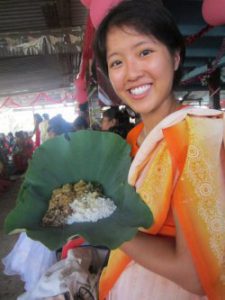The Mosquito Dance
 Every morning and night, I dance while brushing my teeth. I dance because I am happy to be alive, but more importantly, I dance so mosquitoes do not land on my stagnant derriere and inject me with malaria. This might sound like an odd ritual to anyone else, but to other Peace Corps Volunteers and HMI alums, it is no weirder than anything else we do in the backcountry to keep ourselves healthy and sane. As a PCV in rural South America, there are many moments when I look around and realize I have no idea what I am doing, let alone how to do it. Luckily, before total, blind panic sets in, I remember that I have a lot of experience doing things I have never done before. It is called a semester at HMI.
Every morning and night, I dance while brushing my teeth. I dance because I am happy to be alive, but more importantly, I dance so mosquitoes do not land on my stagnant derriere and inject me with malaria. This might sound like an odd ritual to anyone else, but to other Peace Corps Volunteers and HMI alums, it is no weirder than anything else we do in the backcountry to keep ourselves healthy and sane. As a PCV in rural South America, there are many moments when I look around and realize I have no idea what I am doing, let alone how to do it. Luckily, before total, blind panic sets in, I remember that I have a lot of experience doing things I have never done before. It is called a semester at HMI.
When I first got to HMI, I thought I was in over my head. And I probably was. A few years later in Guyana, I realized I definitely was.
Remember when you were little and you would play outside and make mud pies? Here, the school picknie (children in Creolese) make mud curry. The mud here is unlike anything I have ever seen before and rightfully deserves a poem, a painting, or a more thorough explanation at the very least.
When I worked in Korea, I had the opportunity to attend a mud festival. It was a week-long beach extravaganza with mud-lined kiddie pools, free outdoor concerts, and miles of pop up spas. You would bathe in mud, enjoying the silky texture of the thin, slate gray liquid. Then you would bask in the sun and later let it melt away in the ocean, glorying in your smooth, glowing skin, alongside hundreds of other mud-loving enthusiasts.
This is not that kind of mud.
The mud here could make volcanoes on Jupiter. Build ten-story buildings. Fulfill peculiar pregnancy cravings. All-purpose mud.
This amazingly fertile mud loves to encase its caretakers in sticky tentacles of affection. It also ensures that the water around here is brackish and brown, concealing the alligators that live at the bottom of the trenches. During the rainy season students walk barefoot to school and wash off the mud before putting on their shoes to enter the building. My kids are much more practiced than I at this; it is a point of pride that you cannot tell that they just walked miles in mud. I cannot afford pride here. I just want to get from point A to point B with my butt intact.
I have been here for a little over a year now and every day I thank my lucky stars that I walk to school with a bunch of little kids who hold my hands and keep me from falling. It reminds me of my winter expedition when Christian, the History teacher, would hold my heavy sled back every time as I skied downhill, because otherwise I would start skiing backwards, sled first. It was a small gesture, but one I remember to this day.
 We go through life exploring new things and learning from our experiences. Though it might take some time to understand how we have changed, I am amazed by the memories we retain: the low laughter after a long day, the joy in a shared meal, the generosity of strangers. We are where we are today because of the efforts and support of our family and friends.
We go through life exploring new things and learning from our experiences. Though it might take some time to understand how we have changed, I am amazed by the memories we retain: the low laughter after a long day, the joy in a shared meal, the generosity of strangers. We are where we are today because of the efforts and support of our family and friends.
I have realized that my experiences at HMI – besides instilling familiarity with one-Tupperware meals – have prepared me for Peace Corps in immeasurable ways. Most importantly, HMI has ensured that I want to serve in Guyana with passion and purpose. To stand tall at the end of two years and say that I did Peace Corps to the best of my ability, that I have life-long relationships and memories of my community, that I never stopped dancing.
Beth is an Education Volunteer in Peace Corps Guyana. These words are completely her own and do not necessarily reflect the ideas or humor of either the U.S. government or HMI.

